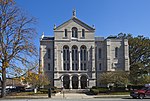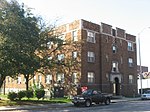The Colonial (Indianapolis, Indiana)
Indianapolis stubsMarion County, Indiana Registered Historic Place stubsNational Register of Historic Places in IndianapolisNeoclassical architecture in IndianaResidential buildings completed in 1900 ... and 2 more
Residential buildings in IndianapolisResidential buildings on the National Register of Historic Places in Indiana

The Colonial is a historic apartment building located at Indianapolis, Indiana, United States. It was built in 1900, and is a three-story, eight bay by ten bay, Classical Revival style yellow brick building. It features a variety of terracotta decorative elements and two-story bay windows on the upper floors.: Part 2, p. 2–3 It was listed on the National Register of Historic Places in 1983.
Excerpt from the Wikipedia article The Colonial (Indianapolis, Indiana) (License: CC BY-SA 3.0, Authors, Images).The Colonial (Indianapolis, Indiana)
North Delaware Street, Indianapolis
Geographical coordinates (GPS) Address Nearby Places Show on map
Geographical coordinates (GPS)
| Latitude | Longitude |
|---|---|
| N 39.772777777778 ° | E -86.154166666667 ° |
Address
Roberts Park United Methodist Church
North Delaware Street 401
46204 Indianapolis
Indiana, United States
Open on Google Maps










